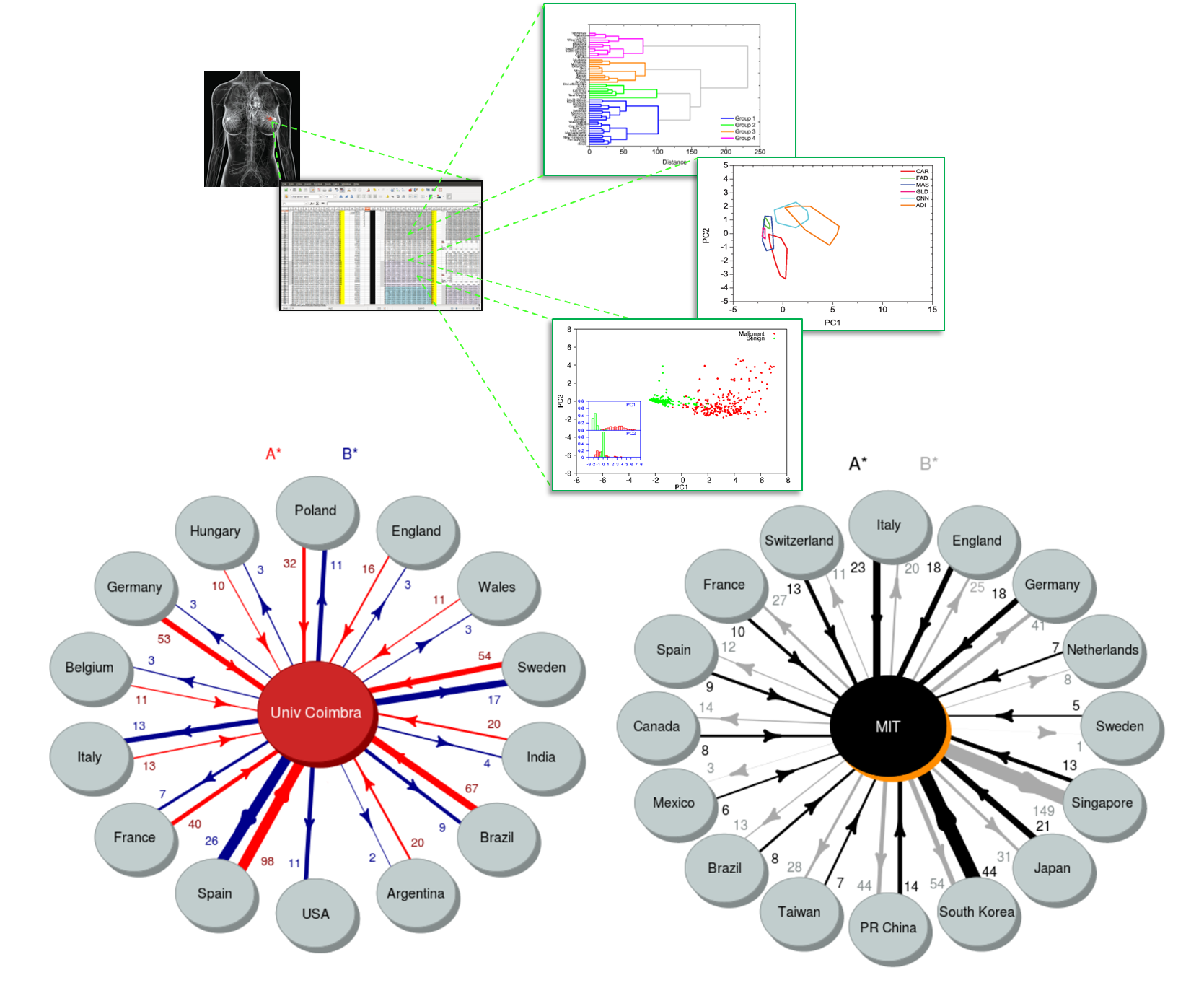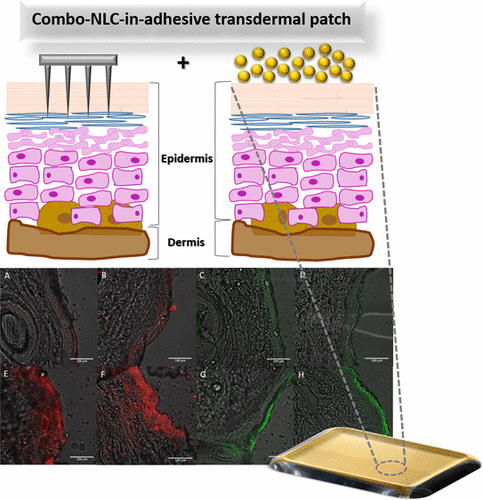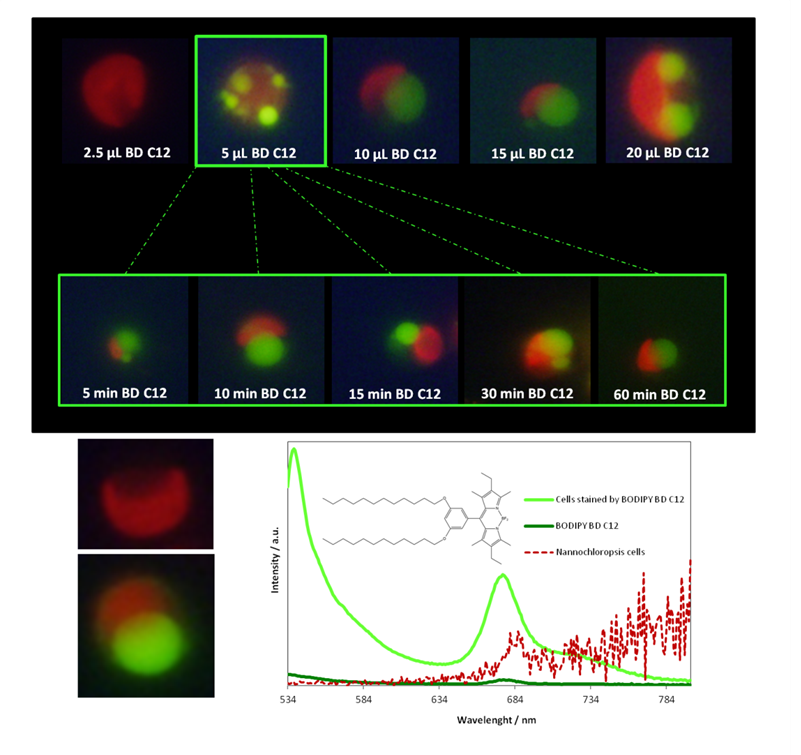Research
Our group at the University of Coimbra, Portugal, is strongly dedicated to computational chemistry, with a direct connection to pharmaceutical technology, in the experimental counterpart. For the former, different aspects and different approaches are used, ranging from coarse-grain simulation to molecular dynamics and ab initio modeling, with the main purpose of relating theory and experiment. Neutral polymers and polylectrolytes, gels, inclusion complexes in pharmaceutics are a significant part of our experience. Recently, host-guest interactions involving novel macrocycles have attracted our attention, mainly in what pertains to the design and characterization of supramolecular systems.
Adsorption of polyelectrolytes on regularly charged surfaces

Representative
snapshots of polyelectrolytes (blue) of different chain lengths
adsorbing on to a positively regularly charged membrane (red). Adsorption
phenomenon is relevant in different areas ranging from biophysics to
technological applications. Different aspects such us molecular
recognition, surface polarization or multilayer deposition can be
addressed.
Polymers and polyelectrolytes in solution: adsorption and confinement

Polyelectrolyte adsorption: positioning, conformation, and patterns
The phenomena of single and multiple chain deposition have been assessed from a novel perspectives based on coarse-grained models, which
emphasizes the conformation and relative arrangement of the deposited
chains. New tools have been proposed
for the analysis of these systems, in which focus is given to
configuration-wise approaches that allow the interpretation of
correlated multi-chain behavior. It is seen that adsorption occurs, with
a minimal effect upon the bulk conformation, even when overcharging
occurs. Also, chain ends create a lower electrostatic potential, which
makes them both the least adsorbed region of the backbone, and the
prevalent site of closer proximity with other chains. Additionally,
adsorption into the most favorable region of the surface overrides, to a
large degree, interchain repulsion.
Polyelectrolyte confinement
The interaction between polyelectrolytes and counterions in confined situations and the mutual relationship between chain conformation and ion condensation is an important issue in several areas. In the biological field, it assumes particular relevance in the understanding of the packaging of nucleic acids, which is crucial in the design of gene delivery systems. In this work, a simple coarse-grained model is used to assess the cooperativity between conformational change and ion condensation in spherically confined backbones, with capsides permeable to the counterions. It is seen that the variation on the degree of condensation depends on counterion valence. For monovalent counterions, the degree of condensation passes through a minimum before increasing as the confining space diminishes.
DNA condensation using mixed cationic agents

Model of a DNA double-helix, B-form, + polycation baring 5 positive charges (dark blue)
Representative snapshots showing the condensation of negative polyelectrolyte (red) in the presence of two types of cationic agents: positive polyelectrolyte (green) and trivalent ions (blue).
Biomembranes, polymers and inclusion complexes

Molecular
Dynamics has been extensively used to study biomembranes and model
conformational aspects of polymer chains in solution. This allows to
follow the atomic motion at a level not accessible to the experimental
observation and, thus, providing detailed information on complex
molecular phenomena.
Computational
modelling of biomembranes for
tumor targeting


Lipid nanoparticles for brain drug targeting
Brain targeting represents a great therapeutic challenge. Drug delivery to the brain is strictly regulated by the blood brain barrier, which represents an overwhelming obstacle for many central nervous system active drugs, in particular for cytotoxics. Drug penetration is only one of several major challenges. The nature of Lipid Nanoparticles confers them distinct advantages over conventional carriers, such as an excellent tolerability, improved physical stability, protection of incorporated labile drugs from degradation, low cost, possibility to modulate drug release due to the solid nature of the lipid matrix, drug targeting, feasibility of scaling-up, and cost-effective production. Moreover, their unique properties, such as reduced size, combined with a large surface area and high drug loading are attractive for a potential improvement in the performance of pharmaceuticals, in particular for brain drug delivery. Int. J. Pharm. (2017) 5;531(1):389-410. doi: 10.1016/j.ijpharm.2017.07.049
Multivariate analysis for medical, epidemiological and bibliometric studies

Clinical tests and epidemiological studies often produce large amounts of data, being multivariate in nature. The respective analysis is, in most cases, of importance comparable to the clinical and sampling tasks. Simple, easily interpretable techniques from chemometrics provide most of the ingredients to carry out this analysis.
The task-force involved in scientific production at the institutional or national level, globally or per area or sub-area of knowledge has been established In the proposed system, the estimated task-force is further divided into core (permanent members of the institution) and collaborators (more mobile members), and allows normalization of scientific production. Research groups/institutions/countries of different sizes/scientific areas can, thus, be directly compared and the time evolution of these groups inspected. Aspects pertaining to collaboration fluxes have been also assessed.
Experimental studies

Cross-sectional picture of porcine skin used in permeation studies (pretreated with a nonionic surfactant) obtained from SEM studies.
Strategies to improve the transdermal delivery of drugs
Transport of drugs through the skin is a challenge due to the nature and barrier function of the stratum corneum. Transdermal drug delivery systems have recently taken advantage of colloidal carriers such as solid lipid nanoparticles (SLN) and nanostructured lipid carriers (NLC) in order to enhance the penetration of drugs through this layer of the skin. SLN and NLC are promising drug delivery systems composed of physiological lipid materials and biocompatible surfactants, which make them safe carriers to apply on the skin.

Transdermal delivery with Lipid Nanoparticles
The role of the combination of Nanostructured lipid carriers (NLC) with chemical enhancers in transdermal patches have been explored. These drug-in-NLC-in-adhesive transdermal patches have been developed for co-delivery of olanzapine and simvastatin. The formulation is optimized for composition in a quality by design basis, in terms of enhancer and adhesive, with focus on permeation behavior, adhesion properties, and cytotoxicity. Molecular dynamics provide a rationale for the experimental observations. For details see Mol. Pharmaceutics, 2017, 14 (6), pp 2099-2115, DOI: 10.1021/acs.molpharmaceut.7b00211

Behavior of Ternary DNA-PEI-Fe(III) Complexes
The mechanism of interaction between components of ternary
DNA-PEI-Fe(III) complexes, using experimental and theoretical approaches has been investigated.
Relevant observations have been complemented by determination of the amount of
Fe(III) included in the polyplexes, which is dependent on
the order of mixture and on the type of PEI, decreasing with
intrinsic PEI condensation efficiency. Aspects arisen from the experimental part have been
rationalized using Monte Carlo simulations.
The deep understanding of these ternary mixtures is a step forward in the optimization of such systems for application in gene delivery
Polyethylenimine and Fe(III) for mediating pDNA transfection
The potential use of Fe(III) ions in biomedical applications may predict the interest of its combination with pDNA-PEI polyplexes. The assessment of the impact of this metal on pDNA complexproperties has been investigated.

Strategies to reduce emissions of carbon dioxide
Microalgae, such as the marine Nanochloropsis, produce biomass through carbon dioxide fixation. This is currently successfully being used in the Portuguese cement industry to reduce emissions of this greenhouse gas. However, there is an urgent need to develop strategies to use the biomass developed in this process.
The evaluation of the double alkyl chain BODIPY series as potential fluorescent lipid probes has been performed. The effect of the staining time investigated in order to determine the photobleaching and the fading characteristics of BODIPY C12. The latter shows resistance to fading and pesents a continuous fluorescence emission during 30 min, displaying exceptionally photo-stability.
